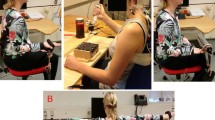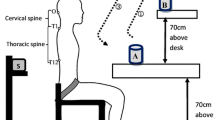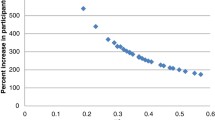Summary
Upper trapezius muscle activity was quantified by electromyogräphic (EMG) recordings using surface electrodes to study occupational muscle load as a risk indicator for the development of shoulder-neck complaints. Thirty-nine female' production workers and thirty-two female office workers showed much larger interindividual differences than the mean difference in muscle activity between the two groups. By comparison with the production workers, the muscle activity patterns of the office workers were characterized by more short pauses and a lower static load. The median load level was similar for the two groups. For the office workers, but not for the production workers, weak correlations were found between symptoms of pain in the shoulder-neck region and some of the EMG parameters (static level and frequency of micropauses > 0.6 s. Current techniques for measuring shoulder muscle load by EMG recordings seem inadequate as screening methods to predict future risk of development of muscle pain symptoms.
Similar content being viewed by others
References
Erdelyi A, Sihvonen T, Helin P, Hänninen O (1988) Shoulder strain in keyboard workers and its alleviation by arm supports. Int Arch Occup Environ Health 60:119–124
Fridlund AJ, Hatfield ME, Cottam GL, Fowler SC (1986) Anxiety and striate-muscle activation: evidence from electromyographic pattern analysis. J Abnorm Psychol 95:228–236
Hagberg M, Wegman DH (1987) Prevalence rates and odds ratios of shoulder-neck diseases in different occupational groups. Br J Ind Med 44:602–610
Jonsson B (1978) Kinesiology - with special reference to electromyographic kinesiology. Contemp Clin Neurophysiol 34:417–428
Jonsson B (1982) Measurement and evaluation of local muscular strain in the shoulder during constrained work. J Hum Ergol (Tokyo) 11:73–88
Kamwendo K, Linton SJ, Moritz U (1991) Neck and shoulder disorders in medical secretaries. Scand J Rehabil Med 23:127–133
Kilbom A, Persson J (1987) Work technique and its consequences for musculoskeletal disorders. Ergonomics 30:273–279
Mathiassen SE, Winkel J (1990) EMG-glenohumeral torque activity in the shoulder-neck region according to arm position and external load. Eur J Appl Physiol 61:370–379
Rimehaug T, Svebak S (1987) Psychogenic muscle tension: the significance of motivation and negative effect in perceptual-cognitive task performance. Int J Psychophysiol 5:97–106
Rossignol AM, Morse EP, Summers VM, Pagnotto LD (1987) Video display terminal use and reported health symptoms among Massachusetts clerical workers. J Occup Med 29:112–118
Sainsbury P, Gibson JG (1954) Symptoms of anxiety and the accompanying physiological changes in the muscular system. J Neurol Neurosurg Psychiatry 17:216–224
Schtildt K, Ekholm J, Harms-Ringdahl K, Arborelius UP, Nemeth G (1987) Influence of sitting postures on neck and shoulder e.m.g. during arm-hand work movements. Clin Biomech 2: 126–139
Veiersted KB (1991) The reproducibility of test contractions for calibration of electromyographic measurements. Eur J Appl Physiol 62:91–98
Veiersted KB, Westgaard RH, Andersen P (1990) Pattern of muscle activity during stereotyped work and its relation to muscle pain. Int Arch Occup Environ Health 62:31–41
Wærsted M, Bjørklund RA, Westgaard RH (1991) Shoulder muscle tension induced by two VDU-based tasks of different complexity. Ergonomics 34:137–150
Westgaard RH (1988) Measurement and evaluation of postural load in occupational work situations. Eur J Appl Physiol 57: 291–304
Westgaard RH, Jansen T (1992a) Individual and work related factors associated with symptoms of musculoskeletal complaints. I. A quantitative registration system. Br J Ind Med 49:147–153
Westgaard RH, Jansen T (1992b) Individual and work related factors associated with symptoms of musculoskeletal complaints. II. Different risk factors among sewing machine operators. Br J Ind Med 49:154–62
Westgaard RH, Wæsted M, Jansen T, Aarås A (1986) Muscle load and illness associated with constrained body postures. In: Corlett EN, Wilson J, Manenica I (eds) The ergonomics of working postures. Taylor and Francis, London, pp 5–18
Westgaard RH, Vasseljen O, Jensen C (1992) Instability of surface EMG recordings from the upper trapezius muscle (Abstr). 9th International Congress of ISEK 1992, Florence, Italy
Westgaard RH, Jensen C, Hansen K (1993) Individual and work related risk factors associated with symptoms of musculoskeletal complaints. Int Arch Occup Environ Health (in press)
Winkel J, Westgaard RH (1992) Occupational and individual risk factors for shoulder-neck complaints. Int J Ind Erg 10: 79–104
Zipp P (1982) Recommendations for the standardization of lead positions in surface electromyography. Eur J Appl Physiol 50: 41–54
Author information
Authors and Affiliations
Rights and permissions
About this article
Cite this article
Jensen, C., Nilsen, K., Hansen, K. et al. Trapezius muscle load as a risk indicator for occupational shoulder-neck complaints. Int. Arch Occup Environ Heath 64, 415–423 (1993). https://doi.org/10.1007/BF00517947
Received:
Accepted:
Issue Date:
DOI: https://doi.org/10.1007/BF00517947




